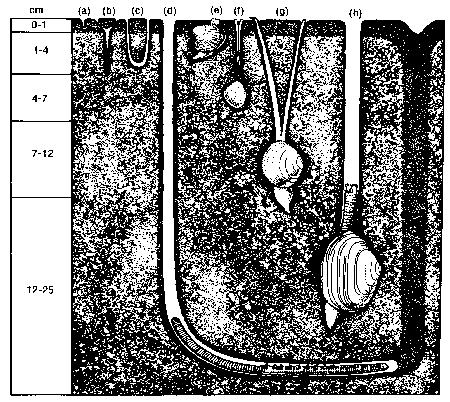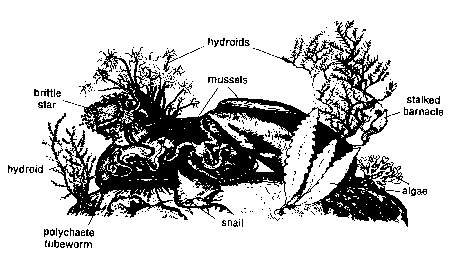|
Navigation
OCB3034
Main Page
FIU
Home
FIU
Marine Biology Home
Dept.
Biology Home
Frank
Jochem Home
E-Mail
|
The Zoobenthos
-
Infauna:
-
live
within the sediment, mostly soft bottom;
-
mostly
clams and worms (polychaetes)
-
borrow
tubes for food scavenging and oxygen supply

-
Epifauna:
-
live
on top of sediment, soft bottom or rocks, attached or free
-
about
80% of larger zoobenthos; hard bottoms more diverse
-
prominent
examples: corals, mussels, starfish, seaearchin, sponges, barnacles

-
Epibenthos
or demersal animals:
live in association with seafloor but temporarily swim up into the water
(prawns, shrimp, cod)
-
Size
classes of zoobenthos:
-
Macrofauna
(also macrobenthos): animals retained by 1.0 mm sieve; largest animals
such as starfish, mussels, corals, sponges
-
Meiofauna
(also meiobenthos): animals 0.1 to 1.0 mm in size, often 0.45 to 1.0 mm
(depending on textbook); small animals commonly found in sand or mud, e.g.
small molluscs, worms, copepods
-
Microfauna
(also microbenthos): smaller than 0.45 mm; mostly protozoa (ciliates, thecate
amoeba, foraminifera)
-
The interstitial
community: „Sandlückensystem“, explored
by Adolf Remane (Kiel, Germany). Animals that live within the water canals
between the sand grains;
-
mostly
microfauna; small body size to „fit into canals“
-
long and
slim bodies, length-to-width ratio up to 100:1 (normal 3-10:1)
-
flexible
bodies because the interstitial room barely provide streight canals
-
organs
to attach temporarily to sand grains to avoid being washed out
-
often
ciliated body surface
-
special
forms occur here, such as single-individual Bryozoa, which normally only
occur as colonial forms
-
some only
recently discovered phyla only occur in the interstitium
-
For some nice
photographs of meiobenthos click here
|

